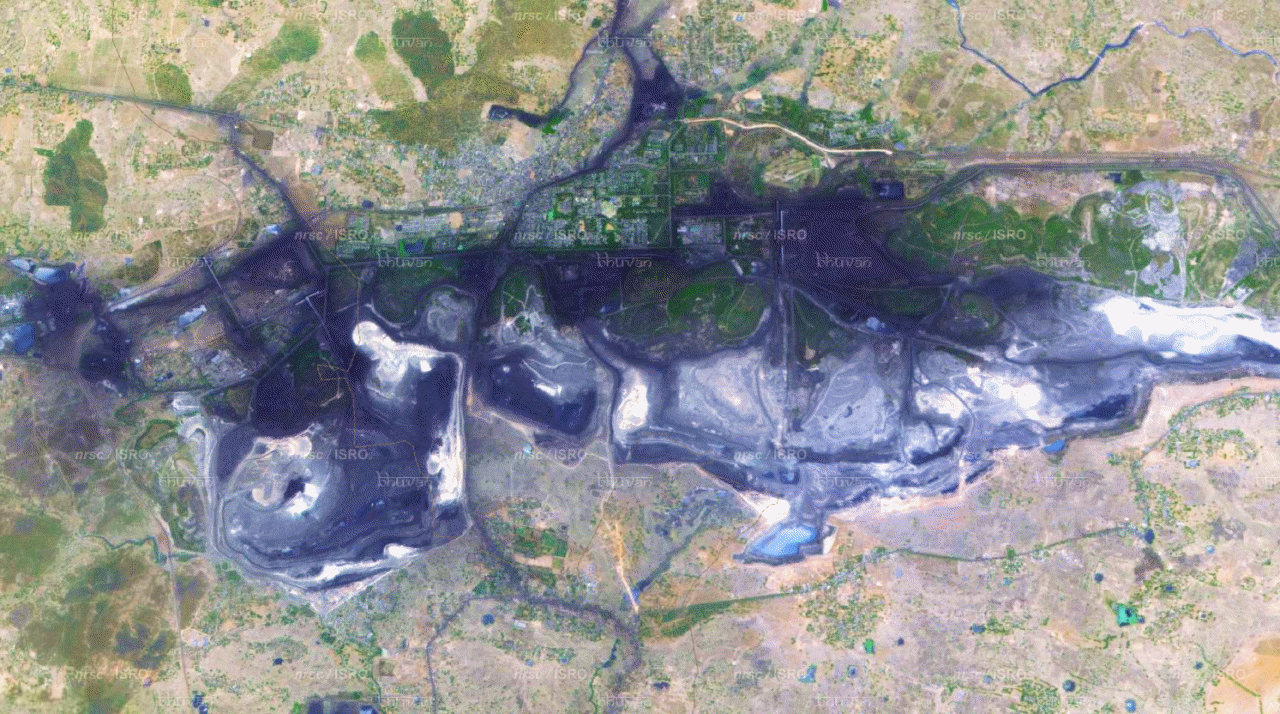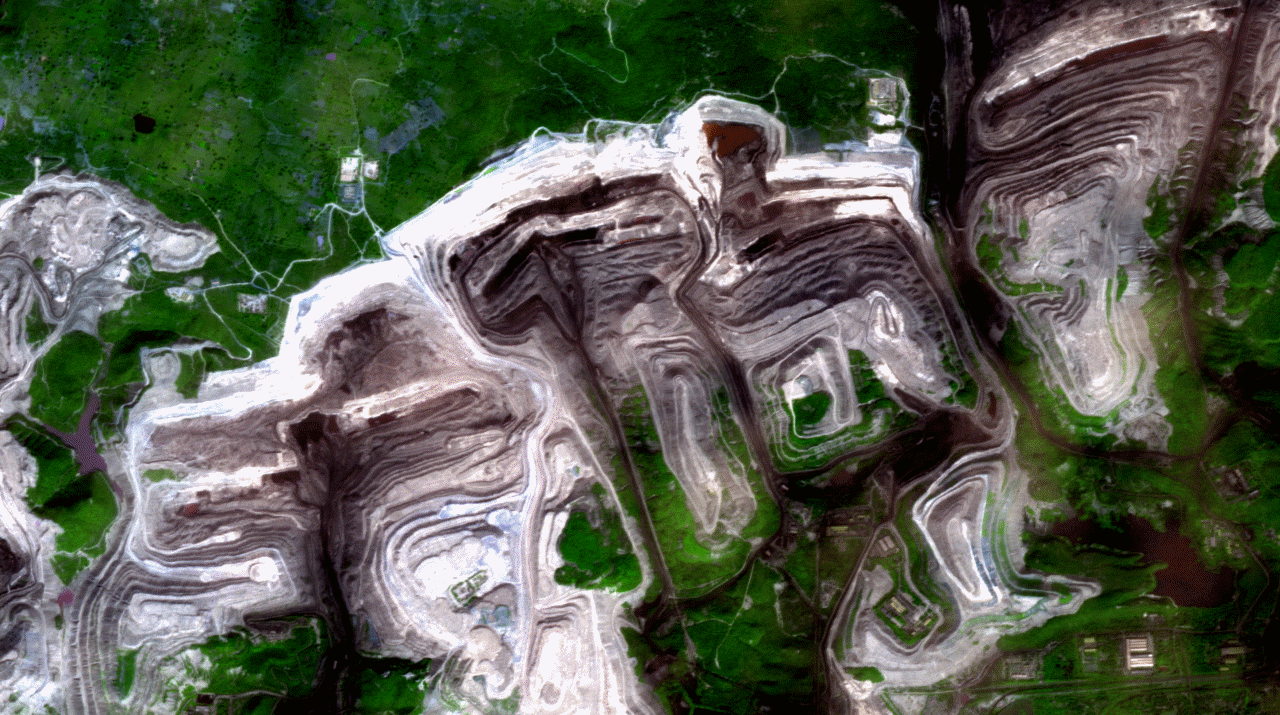[[en]]Coal
is a combustible sedimentary rock formed from ancient vegetation
which has been consolidated between other rock strata and
transformed by the combined effect of microbial action, pressure and
heat over considerable time period. Coal occurs as layers or seams.
It is mostly composed of carbon (50-90%)), hydrogen (3-13%) and
oxygen, with smaller amounts of nitrogen, Sulphur, and other
elements. (CCO, 2017))[[hi]]कोयला प्राचीन वनस्पतियों से निर्मित एक ज्वलनशील तलछटी चट्टान है,
जो अन्य चट्टानों की परतों के बीच एकत्र हो जाता है और लंबी समयावधि में सूक्ष्म जीवों की गतिविधि,
दबाव और गर्मी के संयुक्त प्रभाव से बदल जाता है। कोयला परत या संस्तर के रूप में मौजूद होता है। यह ज्यादातर कार्बन (50-90%),
हाइड्रोजन (3-13%) और ऑक्सीजन से बना होता है, जिसमें नाइट्रोजन, सल्फर और अन्य तत्व न्यून मात्रा में होते हैं। (CCO, 2017))
[[en]]Hard
coal comprises anthracite and bituminous coal. It has a gross
calorific value (moist, ash-free basis) above 24 MJ/kg, or less than
24 MJ/kg provided that the coal has a vitrinite mean random
reflectance greater than or equal to 0.6%. Lignite refers to the
brown coal with a gross calorific value (moist, ash-free basis) less
than 20 MJ/kg. (MOSPI, 2019)[[hi]]कठोर कोयले के अंतर्गत एन्थ्रेसाइट और बिटुमिनस आते हैं।
इसका सकल कैलोरी मान (नम, राख रहित आधार) 24 एमजे/कि.ग्रा. से अधिक है,
या 24 एमजे/कि.ग्रा. से कम है, बशर्ते कि कोयले में विट्रिनाइट औसत यादृच्छिक परावर्तन 0.6% या उससे अधिक हो।
लिग्नाइट का अर्थ भूरा कोयला है जिसका सकल कैलोरी मान (नम, राख रहित आधार) 20 एमजे/कि.ग्रा. से कम होता है। (एमओएसपीआई, 2019)
[[en]]Classification
of Coal in India (CCO, 2017):[[hi]]भारत में कोयले का वर्गीकरण (CCO, 2017):
[[en]]Coking
Coal: The coal with Coking property is referred as Coking coal or
metallurgical coal. It forms coherent beads, free from volatiles,
with strong and porous mass called coke, when it is heated in
absence of air. It is mainly used in steel making and metallurgical
industries.[[hi]]कोकिंग कोयला: कोकिंग गुणधर्म वाले कोयले को कोकिंग कोयला या मेटलर्जिकल कोयला कहा जाता है।
हवा के अभाव में गर्म करने पर, इसमें मजबूत और झरझरे द्रव्यमान के साथ, परिवर्तन से मुक्त, कोक नामक संसक्त मनके बनते हैं।
यह मुख्य रूप से इस्पात बनाने और धातुकर्म उद्योगों में उपयोग किया जाता है।
[[en]]Semi-Coking
Coal: The coal, when heated in the absence of air, forms coherent
beads that are not strong enough for use in blast furnaces, is
called semi-coking coal. It is blended with coking coal in
appropriate proportion to make coke.[[hi]]अर्ध-कोकिंग कोयला: हवा की अनुपस्थिति में गरम करने पर इस कोयले में,
संसक्त मनके बनते हैं जो स्फोट भट्टी में उपयोग के लिए पर्याप्त मजबूत नहीं होते हैं, इसे अर्ध-कोकिंग कोयला कहा जाता है।
कोक बनाने के लिए इसे उपयुक्त अनुपात में कोकिंग कोयले के साथ मिश्रित किया जाता है।
[[en]]Non-Coking
Coal: It does not have coking properties and it mainly used for
power generations. It is also used for cement, fertilizers, glass,
ceramic, paper, chemical and brick manufacturing and for other
heating purposes.[[hi]]गैर-कोकिंग कोल: इसमें कोकिंग गुण नहीं होते हैं और यह मुख्य रूप से बिजली उत्पादन के लिए उपयोग किया जाता है।
इसका उपयोग सीमेंट, उर्वरक, कांच, सिरेमिक, कागज, रसायन और ईंट निर्माण और अन्य ताप प्रयोजनों के लिए भी किया जाता है।
[[en]]Washed
Coal: Processing of coal through water separation mechanism to
improve the quality of coal by removing denser materials (rocks)
and high ash produces washed coal, which has less ash, higher
moisture, better sizing, better consistency, less abrasive, etc.
[[hi]]धुला हुआ कोयला: सघन पदार्थों (चट्टानों) और अधिक राख वाले उत्पादों को हटाकर कोयले की गुणवत्ता में सुधार के लिए जल पृथक्करण तंत्र के माध्यम से कोयले का प्रसंस्करण,
धुले हुए कोयले का उत्पादन करता है, जिसमें कम राख, अधिक नमी, बेहतर आकार, बेहतर स्थिरता, कम अपघर्षक आदि होते हैं।
[[en]]Coal
mining is the process of extracting coal from the ground. Coal is
valued for its energy content and has been widely used to generate
electricity. Steel and cement industries use coal as a fuel for
extraction of iron from iron ore and for cement production.
[[hi]]कोयला खनन जमीन से कोयला निकालने की प्रक्रिया है।
कोयले का महत्व इसकी ऊर्जा की वजह से है और इसका उपयोग व्यापक रूप से बिजली बनाने के लिए किया जाता है।
स्टील और सीमेंट उद्योग कोयले का उपयोग लौह अयस्क से लोहा निकालने और सीमेंट उत्पादन के लिए ईंधन के रूप में करते हैं।
[[en]]Types
of coal mines (CCO, 2017):[[hi]]कोयला खदानों के प्रकार (CCO, 2017):
[[en]]Underground
mining of coal: It refers to extraction of coal from sedimentary
rocks in which the overlying rock is left undisturbed, while the
coal is removed through shafts or tunnels. The underground mining
techniques such as Longwall Mining, Room-And-Pillar Mining etc.,
are applied for sub-surface mining of coal.
[[hi]]कोयले का भूमिगत खनन: यह तलछटी चट्टानों से कोयले के निष्कर्षण को संदर्भित करता है
जिसमें ऊपरी चट्टान को जस-का-तस रहने दिया जाता है, और कोयले को शाफ्ट या सुरंगों के माध्यम से निकाला जाता है।
कोयले के भूमिगत खनन के लिए लॉन्गवाल खनन, रूम-एंड-पिलर खनन आदि, जैसी भूमिगत खनन तकनीक प्रयोग की जाती हैं।
[[en]]Opencast
mining: Open-pit mining, open-cut mining or opencast mining is a
surface mining technique of extracting rock or minerals from earth
by their removal from an open pit or burrow. Open-pit mines are
used when deposits of commercially useful minerals or rocks are
found near the surface owing to relatively thin overburden or due
to structurally unsuitable crust for tunneling.
[[hi]]खुला खनन: ओपन-पिट खनन, ओपन-कट खनन या खुला खनन,
एक खुले गड्ढे या बिल में से चट्टानें अथवा खनिज निकालने की एक सतही खनन तकनीक है।
खुली खानों का उपयोग तब किया जाता है जब अपेक्षाकृत पतली ऊपरी चट्टानों के कारण व्यावसायिक रूप से उपयोगी खनिजों या चट्टानों का जमाव सतह के निकट पाया जाता है,
या फिर भूमि सुरंग बनाने के लिए संरचनात्मक रूप से अनुपयुक्त होती है।
[[en]]Coal
deposits are mainly confined to eastern and south central parts of
the country. The states of Jharkhand, Odisha, Chhattisgarh, West
Bengal, Madhya Pradesh, Telangana and Maharashtra account for 98.26%
of the total coal reserves in the country. As on March 31, 2018, the
estimated reserves of coal were 319.04 billion tonnes, whereas that
of lignite is 45.66 billion tonnes. (MOSPI 2019)
[[hi]]कोयले के भंडार मुख्य रूप से देश के पूर्वी और दक्षिण मध्य भागों तक सीमित हैं।
देश के कुल कोयला भंडार का 98.26% झारखंड, ओडिशा, छत्तीसगढ़, पश्चिम बंगाल, मध्य प्रदेश, तेलंगाना और महाराष्ट्र राज्यों में है।
31 मार्च, 2018 तक कोयले का अनुमानित भंडार 319.04 बिलियन टन था, जबकि लिग्नाइट 45.66 बिलियन टन था। (एमओएसपीआई 2019)
[[en]]Raw
coal coming from mines is washed to remove the ash contents to make
them fit for feeding into boilers, particularly those of steel
plants. Total installed capacity of washeries in the country is
around 127.56 million tonneper Year (MTY) as on 31.3.2018 (MOSPI
2019). Illustration 1 shows coal mines of Korba Coal Field in Chhatisgarh.
Illustration 2 shows coal mines of Singrauli Coal Field in Madhya Pradesh.
[[hi]]खदानों से आने वाले कच्चे कोयले को राख हटाने के लिए धोया जाता है ताकि उन्हें बॉयलर,
खासकर स्टील संयंत्र, में डाला जा सके। 31.3.2018 (एमओएसपीआई 2019) तक देश में वॉशरी की कुल स्थापित क्षमता 127.56 मिलियन टन वर्ष है।
चित्र 1 छत्तीसगढ़ के कोरबा कोयला क्षेत्र की कोयला खानें दर्शाता है।
चित्र 2 मध्य प्रदेश के सिंगरौली कोयला क्षेत्र की कोयला खानें दर्शाता है।

